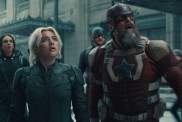3.

As I said before, I was relaxed after First Sequence, which allowed me to be caught off guard. I would not let that happen again. Full Sequence is steamed into my brain like a branding, and I knew going into part three, or The Human Centipede III (Final Sequence) (2015), to be ready for anything.
While clicking through the never ending maze that is iTunes I wondered why I even wanted to watch this movie. I should just go see Mad Max: Fury Road again instead. Then I saw a picture of Six’s smug face. He wanted me to quit, and accept that he had beaten me. I was not going to let that happen. It may seem nuts, but to me, not watching this film would invalidate my entire trek through the devastation genre. Fortunately for my stomach, Final Sequence caught me off guard again not by devastation, but with intrigue.
Tom Six is a smart guy, and he knows that topping his sick, twisted, gore-hound equivalent of Empire Strikes Back would be nearly impossible. Instead he takes a different approach by asking the question that many constantly ask about the trilogy; should these films exist?
Final Sequence again takes the Meta approach and sets itself in a world where both First, and Full Sequence exist. Six also makes a kind-of attempt at setting up a cinematic multi-verse. Both Deiter Laser and Lawrence Harvey return to play new characters. Laser is Bill Boss, a sadistic prison warden, while Harvey plays his accountant Dwight. Together they run a prison full of the most vile criminals in the world. They have no idea how to tame them and are running out of funding trying to figure out a solution. That’s right, there is a financial crisis subplot in this installment and it includes Eric Roberts as a state governor putting pressure on our “heroes”.
Right off the bat Final Sequence feels like a middle ground between the first two films. The return of color makes it decidedly more cinematic than Full Sequence, while maintaining the scummy tone of that film as opposed to the emotional approach of First Sequence. After a series of signature Tom Six scenes including a graphic castration, Bill and Dwight decide the only viable option of correction is to build a five hundred person centipede of all the prisoners. Only issue is they have no idea how to make a centipede other than what they have gathered from watching the films. Who better to help them than Tom Six?
Final Sequence is the only film in the series Tom Six appears playing himself, and it drastically affects the tone. Final Sequence is much more concerned with questioning why people watch these films than it is with merely being another horrific installment. The tone takes that of exploitation, as every line spit by a character is either racist, sexist, or horrifically disturbing in some politically incorrect way. Six makes you ask yourself why you are sitting there watching this as he carefully prods and pokes at every social issue one could be offended by.
Upon witnessing the operation in the film, character Six vomits and runs away to never return. The swan song of his trilogy has such a lack of moral code that even he can’t handle it. Even the victims in the film are mass murderers and rapists as opposed to sympathetic bystanders, giving the audience nowhere to turn for solace.
At the end of the film, the Governor returns to the prison to see it in perfect shape, the budget has been corrected as food costs have drastically declined, and vitamin injections are cheap. The centipede has even reduced the crime rate in America as everyone can agree no life of crime is worth having your face sewn to another inmates anus. As the Governor, Bill, and Dwight look over the massive centipede, Roberts utters the final line in the trilogy, “This is what America needs.” The film fades to black, and credits roll over a rendition of the national anthem. This is a response to the moral question of the films and their place in American culture. But Six doesn’t give us his personal opinion on the matter. Instead, he leaves us to wonder whether or not the line is his own voice as a filmmaker stating that every film should be made regardless of whether there’s an audience for it, or one by a character whom he obviously disagrees with as evidenced when he literally runs away from his own work in fear.
Final Sequence was released with a thud. The film was given a 9% by the godlike opinion that is Rotten Tomatoes. Tom Six took to Twitter and responded with a simple “all the praise makes me humble”. He followed that up by stating many journalists cancelled their interviews with him due to their hate for the film before closing out the tweet with a maniacal “hahahaha.”
Six loves being the villain. He has complete creative control over his films, and he chooses to use that power to decimate audiences. He overrides the question of “should they exist” by simply making them exist; and film is forever. Years down the line a horror fan like myself will pick up this trilogy, and likely be devastated in the way I was. The films exist as a bear trap within the medium waiting for the next viewer to step inside; and that’s exactly the way Tom Six wants it.









